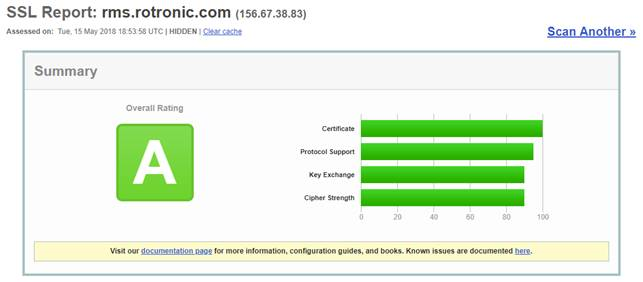Let’s now go a bit deeper. RMS software is an aspx.net software package. As an aspx.net system it runs server side and the user interface is via a web browser or app through standard client devices (PC or smart device). All data is stored on a MS-SQL database.
The software is programmed using ASP.NET, VB.NET and JavaScript. The software is developed following the GAMP©5 guidelines and continuous requirement engineering, iterative software development with bi-yearly releases and a three year time frame for larger releases.
The RMS cloud has an SSL A rating:

For many organizations once end-users approve of a system the challenge is getting the system approved and installed in line with wider corporate policies and security. So far we have found that in discussions with IT project managers and cyber security managers, RMS has met their requirements – usually much to the surprise of the end users who perhaps initially expect a protracted battle!
The RMS software has two core elements:
•Web service:
oThis is the software aspect of RMS. The web service provides the interactive web page to present data for end users and allow system configuration. The web service also works in the background to interact with hardware and the database. Typically the web page will be part of the local intranet with an address like rms.yourorganisation.com, optionally the web page can also be made accessible from the internet outside your organization (like our cloud service which is available at http://rms.rotronic.com/rms). For the clients (end users) no special software or plug ins are required just a standard web-browser.
oMore technically the RMS web service is built around ASP.Net framework and runs under Windows IIS (internet information services). The web service therefore requires a Windows Server (2008, 2012 or 2016). The RMS software can be run on a standard PC with IIS enabled but this is not usually advised except for specific applications.
oThe web software runs under Windows IIS and generates standard aspx.net web pages. No client plugins are required to access the web software interface simply a standard web browser.
•SQL Database:
oThe second part of the RMS is its database. All device, configuration, user and measured data is stored within a standard MS-SQL database. The database is accessed by the web service to store and read data as required. An existing SQL server can be used if available, otherwise SQL-Express is free to install.
oMore technically the RMS database requires Microsoft-SQL Express or higher, the database can be on the same server as the webservice or a separate machine.
oAs RMS is built around standard server based systems, there is full support for load balancing and failover, as such should a webserver or SQL server fail a redundant/spare can take over. This is standard procedure for larger IT systems.
oIIS server and MS-SQL server can be on the same or separate servers. Load balancing and redundant servers for both SQL and IIS are supported and recommended for large installations.
oNo personal data is stored outside the SQL database (the hardware only stores a unique serial code, date, time and measured values – as such no private data passes between hardware and software).
The RMS hardware:
•All Rotronic hardware is ethernet based or wireless back to ethernet gateways. Ethernet devices can be powered via PoE, 24VDC and/or batteries, wireless devices are powered either by battery and/or 24VDC. Selected third party devices may require local mains/24VDC power. RMS devices communicate back to the server via port 80. All RMS hardware initiates communication to the server (client-server model). Hardware can be initially configured with IP configuration and server address via RMS-Config software (windows application) or in advance by Rotronic. RMS supports multisite projects and remote servers.
•The wireless devices communicate over 868/915MHz back to an Ethernet Gateway. 868 and 915MHz are low frequency industrial radio bands. We use a proprietary communication protocol and the only information transmitted is the device serial number, time and measured values. All additional data (name, location, owner, alarm conditions etc is stored and used by the server software and associated MS-SQL database).
•A note on RMS hardware; All Rotronic hardware initiates communication with the webservice via port 80. For cloud applications this means only port 80 must be opened outbound to allow the devices to initiate outbound communications to the server. All gateways have standard IP configurations (DHCP or fixed).
•Third party data/device support is possible via RESTful API or direct interaction within the SQL database.
An overview of the RMS communication can be seen here: RMS Communication Overview.
Some other technical points about RMS:
•The on-premise software can be installed on your local servers completely inside your firewall. All functions of RMS can be operated from within your network. Internet access is only required for SMS and Telephone alerts. The RMS software has no issues with automatic updates of the operating system. When the server is offline, the values are stored within the data logger (no alarms are triggered during this time). The data can automatically be sent to the database once the system is up and running again.
•RMS supports LDAP log ins so can utilize existing user names and passwords from your systems.
•Full user rights structures can be created via RMS ensuring selected access and rights for every device, function and user.
•RMS supports optional third party digital data/device/software integration via a JSON API to write data to RMS and read data out. In addition direct interaction with the SQL is possible for third party analytics and reporting. As standard RMS generates PDF and CSV exports via web interface. Data is stored permanently on the SQL database, RMS Enterprise version includes an archive function so inactive devices are archived within the system (all log, event, system data related to archived devices is still on the SQL database and accessible via the archive section of the web software).
•The Web page data is binary coded and authentication uses AES128 encryption, Key exchange uses diffie-hellman key algorithm.
Updated 29.05.2024